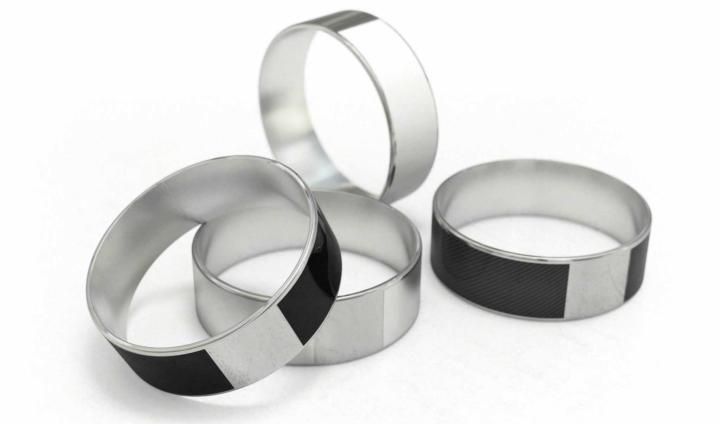
Already smashing through a £30,000 ($46,464) funding goal on Kickstarter, the NFC Ring is a simple steel or titanium ring that has near-field communication (NFC) functionality built into the design. Offering two separate inlays within the ring, the top inlay allows users to share public information with friends, like a Twitter username, using a bump gesture with another device. The bottom inlay is used to perform more private actions like unlocking your smartphone or placing the palm of your hand on the front door of your home to unlock a NFC-enabled door lock.
Conceptually, the bottom inlay is more secure since the user can clench their fist to protect from any actions or simply keep their hands faced down and away from devices. The bottom inlay is also significantly smaller than the top inlay, thus providing additional security for private data and making public data easier to share with an acquaintance. The read distance is extremely short at just one millimeter and the two inlays to “generate cross talk” in case anyone around you is attempting to read information at a distance using a high-powered antenna.

Since the read distance is so small, the creator of the NFC Ring recommends placing a sticker on your smartphone to indicate the closest point to the NFC antenna. In addition, some smartphones, the Samsung S4 and Z10 for instance, will require the alpha version of the NFC ring instead of the normal version because the manufacturer placed the battery too close to the NFC antenna.
Besides Twitter, other public actions that can be accomplished at launch include sharing contact information, a Facebook profile, a YouTube account, a URL for a personal site or the Wi-Fi password to a home’s network. However, the software is publicly available on Github in order to allow developers to create their own ring actions and hopefully share those with the community.

Of course, there’s no iPhone support because Apple didn’t include NFC connectivity in the smartphone’s design. The ring can hold approximately 144 bytes of data and does not require a battery or any form of charging. It comes in sizes between 7 to 15 and is also water-resistant
Beyond smartphones and door locks, other hardware that can communication with the NFC ring easily include the Raspberry Pi and Arduino board. The development team isn’t pursing payment functionality with the NFC Ring since it requires a significant amount of encryption to accomplish, but a user’s Bitcoin account information can be given out publicly to another device in order to receive a Bitcoin payment.
Regarding pricing, the base price for a NFC Ring at launch is £22 ($34). According to the Kickstarter product page, the NFC Ring team plans to ship the basic hardware by September 2013 and custom designs by October 2013. Before backing a project on Kickstarter, be aware that manufacturing issues can often delay the estimated delivery windows of a product by weeks or even months.


